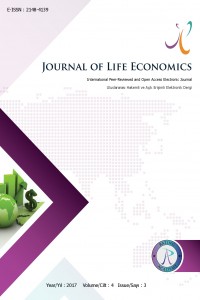MERKEZ BANKASI BAĞIMSIZLIĞININ EKONOMİK BÜYÜME ÜZERİNDEKİ ETKİLERİ: AB ÜLKELERİ ÜZERİNE YENİ NESİL PANEL VERİ ANALİZİ (1995-2015)
Abstract
Bu çalışmada, Avrupa Birliği (AB) üyesi ülkelerde merkez bankası yasal bağımsızlık düzeyinin ekonomik büyüme üzerindeki etkileri 1995-2015 dönemi için yeni nesil panel veri analizi metodolojisi kapsamında ekonometrik olarak incelenmektedir. Bu açıdan çalışmada, AB ülkelerinde merkez bankalarının temel hedefleri olarak belirlenen fiyat istikrarının sağlanabilmesine ve sürdürülebilmesine yönelik tesis edilen yasal bağımsızlık düzeylerinin, üye ülkelerin ekonomik büyüme performansları üzerinde teorik yazında öngörüldüğü gibi bir etkiye sahip olup olmadığının ampirik açıdan da değerlendirilmesi amaçlanmaktadır. Çalışma sonucunda, inceleme döneminde AB ülkelerinde merkez bankası yasal bağımsızlık düzeyinin ekonomik büyüme üzerinde pozitif yönlü ve istatistiki açıdan anlamlı bir etkiye sahip olduğu belirlenmiştir. Bu sonuçlar, merkez bankası yasal bağımsızlık düzeyinin ekonomik büyüme üzerinde teorik çerçevede öngörülen etkilerinin, çalışma dönemi itibariyle AB ülkelerinde ampirik açıdan da geçerli olduğunu göstermektedir. Bununla birlikte sonuçlar, AB ülkelerinin reel ekonomik büyüme performanslarının arttırılmasında ve uzun dönemde sürdürülebilirlik kazanmasında merkez bankalarının yasal bağımsızlık düzeylerinin de mevcut yapısıyla önemli bir etkiye sahip olduğuna işaret etmektedir.
Keywords
Sürdürülebilir Ekonomik Büyüme Merkez Bankası Yasal Bağımsızlık Endeksi Avrupa Birliği Ülkeleri Yeni Nesil Panel Veri Analizi
References
- AKHAND, H. A., 1998, Central Bank Independence and Growth: A Sensitivity Analysis, Canadian Journal of Economics, 31, 303-17. ALESINA, A. ve SUMMERS, L. H., 1993, Central Bank Independence and Macroeconomic Performance: Some Comparative Evidence, Journal of Money Credit and Banking, 25(2), 151-162. ALESINA, A. ve GATTI, R., 1995, Independent Central Banks: Low Inflation at No Cost?, The American Economic Review, 85(2), 196-200. ALTINTAŞ, H. ve SAMİ, T., 2002, Gelişmekte Olan Ülkelerde Merkez Bankası Bağımsızlığı: Karşılaşılan Güçlükler ve Sınırlamalar, Uludağ Üniversitesi iktisadi ve idari Bilimler Fakültesi Dergisi, 21(2), 27-45. ANASTASIOU, A., 2009, Central Bank Independence and Economic Performance. Cyprus Economic Policy Review, 3(1), 123-156. ARNONE, M. LAURENS, B. J. ve SEGALOTTO J. F., 2006, The Measurement of Central Bank Autonomy: Survey of Models, Indicators, and Empirical Evidence, IMF Working Paper, No: WP/06/227. BANAIAN, K., BURDEKIN, R. C. ve WILLETT, T. D., 1998, Reconsidering the Principal Components of Central Bank Independence: The More the Merrier?, Public Choice 97(1), 1-12.
THE EFFECTS OF CENTRAL BANK INDEPENDENCE ON ECONOMIC GROWTH: NEW GENERATION PANEL DATA ANALYSIS ON THE EU COUNTRIES (1995-2015)
Abstract
In this study, the effects of the level of statutory independence of the central bank on economic growth in the European Union (EU) member countries are examined econometrically in the context of new generation panel data analysis methodology for the period 1995-2015. In the study from this aspect, it is aimed to empirically assess whether the level of statutory independence established for the maintenance and sustainability of price stability which is the main objective of central banks in the EU countries, has an effect on the economic growth performances of member countries as is predicted in the theoretical framework. As a result of the study, it was determined that of the level of statutory independence of the central bank in EU countries had a positive direction and statistically significant effect on economic growth during the review period. These results show that the predicted effects on the theoretical framework of the level of statutory independence of the central bank on economic growth are also empirically valid in the EU countries as of the study period. However, the results suggest that of the levels of statutory independence of the central banks with the current structure have also a significant impact on the real economic growth performance of the EU countries is enhanced and achieved sustainability in the long-term.
Keywords
Sustainable Economic Growth Central Bank Statutory Independence Index The European Union Countries New Generation Panel Data Analysis
References
- AKHAND, H. A., 1998, Central Bank Independence and Growth: A Sensitivity Analysis, Canadian Journal of Economics, 31, 303-17. ALESINA, A. ve SUMMERS, L. H., 1993, Central Bank Independence and Macroeconomic Performance: Some Comparative Evidence, Journal of Money Credit and Banking, 25(2), 151-162. ALESINA, A. ve GATTI, R., 1995, Independent Central Banks: Low Inflation at No Cost?, The American Economic Review, 85(2), 196-200. ALTINTAŞ, H. ve SAMİ, T., 2002, Gelişmekte Olan Ülkelerde Merkez Bankası Bağımsızlığı: Karşılaşılan Güçlükler ve Sınırlamalar, Uludağ Üniversitesi iktisadi ve idari Bilimler Fakültesi Dergisi, 21(2), 27-45. ANASTASIOU, A., 2009, Central Bank Independence and Economic Performance. Cyprus Economic Policy Review, 3(1), 123-156. ARNONE, M. LAURENS, B. J. ve SEGALOTTO J. F., 2006, The Measurement of Central Bank Autonomy: Survey of Models, Indicators, and Empirical Evidence, IMF Working Paper, No: WP/06/227. BANAIAN, K., BURDEKIN, R. C. ve WILLETT, T. D., 1998, Reconsidering the Principal Components of Central Bank Independence: The More the Merrier?, Public Choice 97(1), 1-12.
Details
| Primary Language | Turkish |
|---|---|
| Journal Section | Articles |
| Authors | |
| Publication Date | July 31, 2017 |
| Published in Issue | Year 2017 Volume: 4 Issue: 3 |


